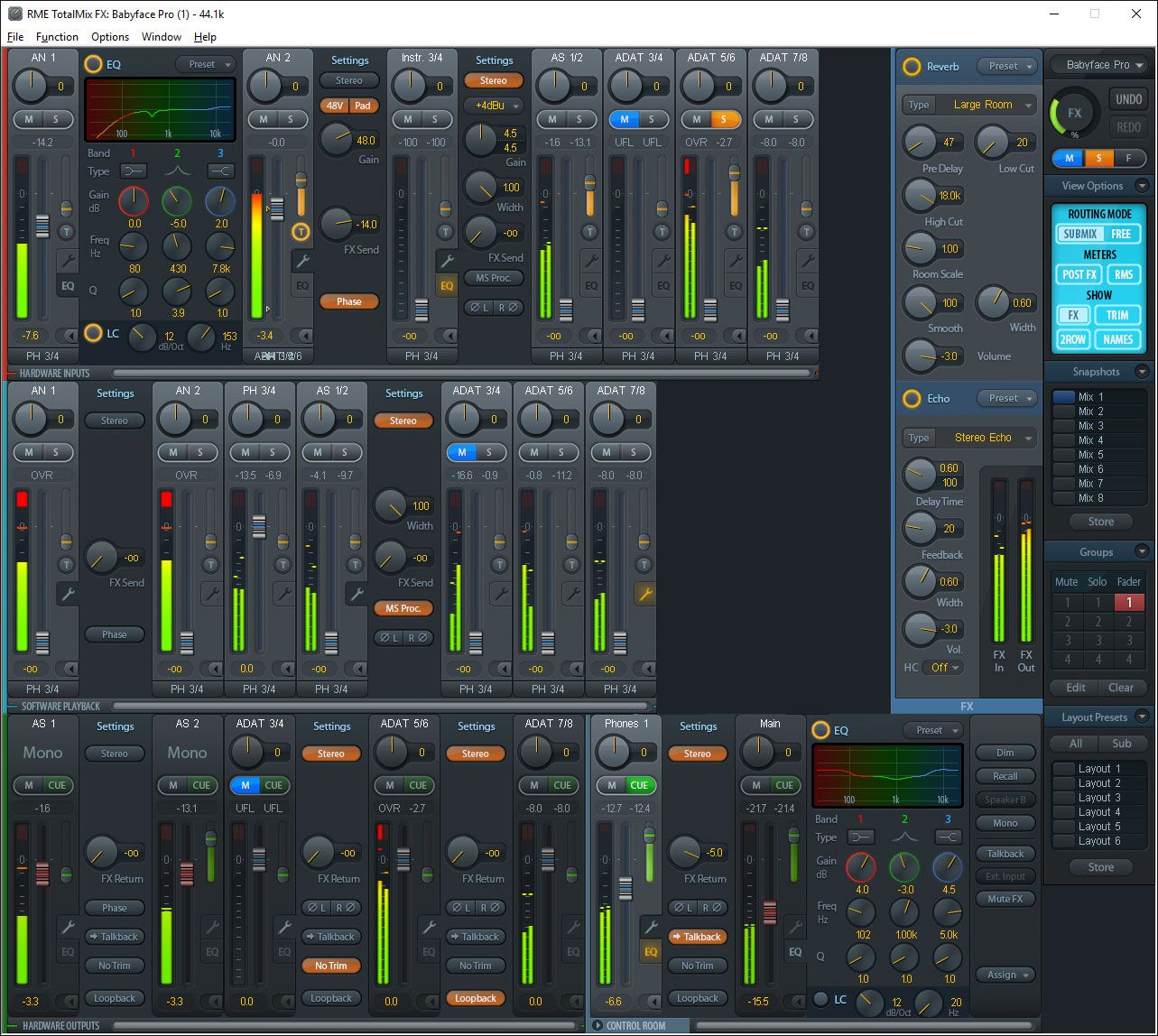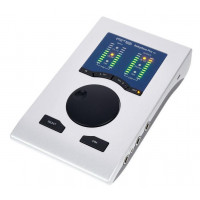Overview
Connectivity
- 12 Input and 12 Output channels
- 4 x Analog Inputs (Mic, Line, Instrument)
- 4 x Analog Outputs (2 x XLR, 2 x Phones)
- 1 x ADAT I/O or 1 x SPDIF I/O optical
- 1 x MIDI I/O
- 1 x USB 2.0 (USB 3 compatible)
- Digital Gain control on all inputs
- Separate outputs for high and low impedance headphones
- TotalMix FX (with EQ, Reverb, Echo)
The exciting Babyface Pro once again demonstrates RME’s absolute commitment to superior craftsmanship, not only in audio circuits and driver development, but also in mechanics.
Created with the highest precision from a block of aluminum, this high-end yet portable interface incorporates newly designed analog and digital circuits. Its innovative energy saving technologies provide supreme fidelity with no compromises in level, noise or distortion.
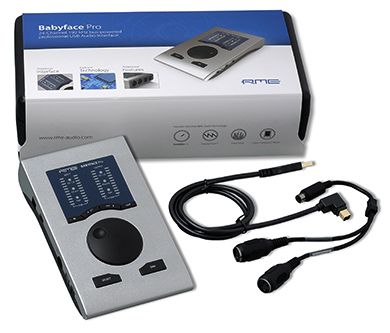
Progressive Interface
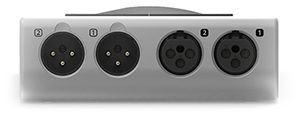
For the main I/O RME have designed a completely new XLR socket, which integrates seamlessly into the housing and saves space.
The two headphone outputs, offering TRS and mini-jack sockets in parallel, have completely separate driver stages to perfectly match low and high impedance headphones, guaranteeing pristine sonic results no matter what type of headphone is used.
Two digitally controlled preamps provide individually switchable 48V phantom power. These brand new circuits feature a gain range of 76 dB, adjustable in steps of 1 dB, including a relay-driven PAD, resulting in exceptional EIN (Equivalent Input Noise) performance as well as line overload protection, and enough gain for even the lowest level microphones.
Babyface Pro’s incredibly efficient design almost never requires an external power supply – it’s perfectly stable on USB 3 bus power, and also most USB 2 ports, with no degradation in any technical specification. This makes it perfect for mobile recording, even with a pair of your favourite condenser microphones.
The comprehensive feature set continues with an optical TOSLINK I/O; use as either an ADAT port with SMUX support or SPDIF for sessions up to 192 kHz. In combination with an external ADAT converter, the Babyface Pro fully supports 12 analog inputs as well as 12 outputs, making it ideal for both live and studio multi-track applications. You can plug any instrument, line or high impedance, into Babyface Pro’s jack inputs 3 & 4. Record your guitar on the go, with no additional hardware required. MIDI I/O via an included breakout cable completes the package.
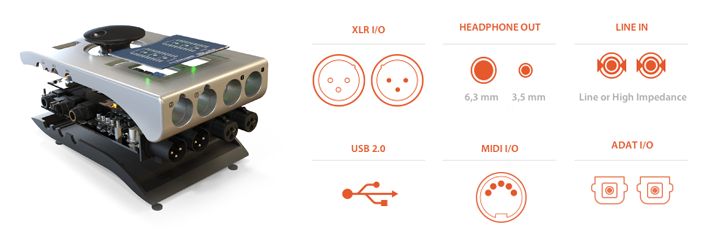
Profound Technology
Babyface Pro ships with RME’s TotalMix FX, available for Windows and Mac OS X. An iOS version is available as well. This amazingly versatile software allows you to use Babyface Pro in any situation. For example mixing your guitar and vocals to headphones has never been easier.
The FPGA-based DSP mixer adds a flexible, 3-band parametric equalizer to all inputs and outputs. Reverb and delay FX are also available.
Latest generation low latency AD/DA converters, combined with RME’s unique SteadyClock technology, result in exceptional specifications that will satisfy the most demanding of professionals.
Combining a huge feature set with sonic excellence and intuitive control, whether for the studio or on the move, the RME Babyface Pro is the most comprehensive and versatile compact audio interface ever built.
| A field-programmable gate array (FPGA) is an integrated circuit designed to be configured by a customer or a designer after manufacturing. | The Class Compliant mode is a standard that is natively supported by operating systems like Windows, Mac OS X, Linux distributions, and hardware like Apple’s iPad. No proprietary drivers are required, the device will be directly recognized. | Due to the highly efficient jitter reduction, the converters operate as if they are working with internal clock all the time - guaranteeing a pristine sound experience! | TotalMix FX is RME’s superior hardware mixer. It delivers fully flexible mixing/routing with many superior features for studio and live work, still maintaining exemplary overview and usability. |
Professional Features
Straight to the core without interference: the reference design of the Babyface Pro leaves nothing to be desired.
RME devices are designed to conserve music as it is. Audio signals are passed in their entirety, nothing added, nothing taken. For the new Babyface, the audio circuits have been improved to meet even highest gain levels with best dynamic range.
The clever user interface is informative and clearly laid out. It makes access to every feature and configuration mode of the Babyface Pro intuitive and easy to use.
Even in stand-alone mode, routing and mixing of inputs to outputs directly on the device opens a whole world of possible applications.
TotalMix FX
The next generation of TotalMix delivers hardware mixing/routing with lots of new features and a highly improved usability. For a seamless integration of the new features TotalMix has been rewritten from the ground up. The DSP mixer now not only matches features of high-end digital consoles but even adds effects like a 3-band parametric EQ plus Low Cut on all input and output channels. The Babyface also provides a separate FX send bus for all inputs and software playback channels, feeding two effect engines: Reverb and Echo. Every output channel includes a FX return control for the FX output signal.
Features/Differences to classic TotalMix:
- New design and improved usability
- Control Room Section: Dedicated section for the main output (e. g. studio monitors) and other monitoring outputs (e. g. phones). All existing stereo output channels can be freely assigned as source for the control room section channels.
- Four definable groups for Solo, Mute and Faders
- Switchable Mono and Stereo channel view
- Channel Options: Stereo Width, MS Processing, Phase L/R
- Trim mode: Adjusts the volume for all routed signals of a channel. This option allows to modify the volume of all sends of a channel simultaneously, equalling a hardware's trim functionality.
- Unlimited Undo and Redo
- FX Sends and Returns: One send bus for every input/playback channel with Reverb/Echo
- Expandable channel view for channel settings and EQ setup
- Slim channel mode for selected or all channels, to save space or give a meter bridge view
- 2-Row Mode: reduces the height of the mixer to two rows for smaller displays
The DSP-based hardware calculates RMS and Peak levels for all channels without causing any CPU load.
Technical Specifications
Analog
AD, Microphone/Line 1-2
- Input: XLR, electronically balanced
- Input impedance balanced: 2 kOhm, 5.2 kOhm with PAD
- Input impedance unbalanced: 1 kOhm, 2.6 kOhm with PAD
- Signal to Noise ratio (SNR): 113 dB RMS unweighted, 116 dBA
- Frequency response @ 44.1 kHz, -0.1 dB: 18 Hz – 20.8 kHz
- Frequency response @ 96 kHz, -0.5 dB: 7 Hz – 45.8 kHz
- Frequency response @ 192 kHz, -1 dB: 5 Hz – 92 kHz
- With PAD active : -0.1 dB 8 Hz, -0.5 dB < 4 Hz, -1 dB < 3 Hz
- THD: < -110 dB, < 0.00032 %
- THD+N: < -104 dB, < 0.00063 %
- THD @ 30 dB Gain: < -107 dB, < 0.0004 %
- THD+N @ 30 dB Gain: < -100 dB, < 0.001 %
- Channel separation: > 110 dB
- Gain range: -11 dB up to +65 dB
- Maximum input level XLR, Gain 0 dB: +8 dBu, PAD +19 dBu
- Maximum input level XLR, Gain 65 dB: -57 dBu, PAD -46 dBu
AD, Line/Instrument In 3-4
As Microphone/Line 1-2, but:
- Input: 6.3 mm TS jack, unbalanced
- Input impedance: 470 kOhm
- Signal to Noise ratio (SNR): 114 dB RMS unweighted, 117 dBA
- Frequency response @ 44.1 kHz, -0.1 dB: 5 Hz – 20.8 kHz
- Frequency response @ 96 kHz, -0.5 dB: < 3 Hz – 45.8 kHz
- Frequency response @ 192 kHz, -1 dB: < 2 Hz – 92 kHz
- Maximum input level @+4 dBu, Gain 0 dB: +13 dBu
- Maximum input level @-10 dBV, Gain 9 dB: -5 dBu
DA, Line Out 1-2
- Dynamic range (DR): 115 dB RMS unweighted, 118 dBA
- Frequency response @ 44.1 kHz, -0.5 dB: 0 Hz – 20.8 kHz
- Frequency response @ 96 kHz, -0.5 dB: 0 Hz – 45 kHz
- Frequency response @ 192 kHz, -1 dB: 0 Hz - 89 kHz
- THD: - 106 dB, 0.0005 % • THD+N: -102 dB, 0.0008 %
- Channel separation: > 110 dB
- Output: XLR balanced
- Output impedance: 300 Ohm balanced, 150 Ohm unbalanced
- Output level @ 0 dBFS: Balanced +19 dBu, unbalanced +13 dBu
- DC @ 0 dBFS: 6.35mm 4.8 V, 3.5mm 2.4 V, XLR bal. 9.6 V
DA, Phones 3/4
AS DA Line Out, but:
- Output: 6.3 mm TRS jack, unbalanced
- Output impedance: 10 Ohm
- Output level at 0 dBFS, 1 kOhm load: +13 dBu
- Max power @ 0.1% THD: 50 mW
- Output: 3.5 mm TRS jack, unbalanced
- Output impedance: 2 Ohm
- Output level at 0 dBFS, 1 kOhm load: +7 dBu
- Max power @ 0.1% THD: 70 mW
MIDI
- 1 x MIDI I/O via breakout cable with 2 x 5-pin DIN jacks
- Galvanically isolated by optocoupled input
- Hi-speed mode: Jitter and response time typically below 1 ms
- Separate 128 byte FIFOs for input and output 25.3
Digital
- Clocks: Internal, ADAT In, SPDIF In
- Low Jitter Design: < 1 ns in PLL mode, all inputs
- Internal clock: 800 ps Jitter, Random Spread Spectrum
- Jitter suppression of external clocks: > 50 dB (2.4 kHz)
- Effective clock jitter influence on AD and DA conversion: near zero
- PLL ensures zero dropout, even at more than 100 ns jitter
- Digital Bitclock PLL for trouble-free varispeed ADAT operation
- Supported sample rates: 28 kHz up to 200 kHz
Digital Inputs
ADAT Optical
- 1 x TOSLINK
- Standard: 8 channels 24 bit, up to 48 kHz
- Double Speed (S/MUX): 4 channels 24 bit 96 kHz
- Quad Speed (S/MUX4) : 2 channels 24 bit 192 kHz
- Bitclock PLL ensures perfect synchronisation even in varispeed operation
- Lock Range: 31.5 kHz – 50 kHz
- Jitter when synced to input signal: < 1 ns
- Jitter suppression: > 50 dB (2.4 kHz)
SPDIF optical
- 1 x optical, according to IEC 60958
- Accepts Consumer and Professional format
- Lock Range: 27 kHz – 200 kHz
- Jitter when synced to input signal: < 1 ns
- Jitter suppression: > 50 dB (2.4 kHz) 25.5
Digital Outputs
ADAT optical
- 1 x TOSLINK
- Standard: 8 channels 24 bit, up to 48 kHz
- Double Speed (S/MUX): 4 channels 24 bit 96 kHz
- Quad Speed (S/MUX4) : 2 channels 24 bit 192 kHz
SPDIF optical
- 1 x optical, according to IEC 60958
- Format Consumer (SPDIF) according to IEC 60958
- Sample rate 28 kHz up to 200 kHz
General
- Power supply: USB bus power or external power supply
- Typical power consumption: 2.9 Watts
- Max. power consumption: 4.6 Watts
- Current at 5 V bus power operation: 600 mA (2.9 Watts)
- Current at 12 V external power: 240 mA (2.9 Watts)
- Dimensions (WxHxD): 108 x 35 x 181 mm (4.25" x 1.4" x 7.1")
- Weight: 680 g ( 1.5 lbs)
- Temperature range: +5° up to +50° Celsius (41° F up to 122°F)
- Relative humidity: < 75%, non condensing
Driver support
- Windows 10 / 8 / 7 / Vista / XP SP2 (32 & 64 bit)
- Apple Mac OS X 10.6 or up (Core Audio)
System Requirements
Computer with at least Pentium Core 2 Duo CPU.
Additional Information
| Manufacturer | RME |
|---|---|
| Model | BabyfacePro |





